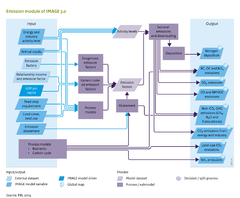Emissions: Difference between revisions
Jump to navigation
Jump to search
m (Text replace - "CO, NMVOC emissions" to "CO and NMVOC emissions") |
m (Text replace - "Non CO2 GHG emissions (CH4, N2O, Halocarbons)" to "Non CO2 GHG emissions (CH4, N2O and Halocarbons)") |
||
| Line 4: | Line 4: | ||
|InputVar=Energy and industry activity level; Feed crop requirement; Animal stock; Land cover, land use - grid; Emission abatement; GDP per capita; | |InputVar=Energy and industry activity level; Feed crop requirement; Animal stock; Land cover, land use - grid; Emission abatement; GDP per capita; | ||
|Parameter=Emission factors; Relationship income and emission factor; | |Parameter=Emission factors; Relationship income and emission factor; | ||
|OutputVar=CO2 emission from energy and industry; CO and NMVOC emissions; Non CO2 GHG emissions (CH4, N2O | |OutputVar=CO2 emission from energy and industry; CO and NMVOC emissions; Non CO2 GHG emissions (CH4, N2O and Halocarbons); BC, OC and NOx emissions; SO2 emissions; Nitrogen deposition - grid; | ||
|Description=Emissions of greenhouse gases and air pollutants are an important cause of environmental problems such as climate change, acidification, eutrophication, urban air pollution and water pollution. Better understanding the drivers of these emissions and the different ways to abate them is therefore important to assess global environmental problems. Greenhouse gas and air pollutant emiissions stem from a range of sources, both anthropogenic and natural ones. The former category includes energy consumption and production, industrial processes, agriculture and land use change. The latter include wetlands, oceans and unmanaged land. In this chapter we provide a description of the approaches used in IMAGE to calculate emissions from a variety of sources and sectors in a consistent manner. | |Description=Emissions of greenhouse gases and air pollutants are an important cause of environmental problems such as climate change, acidification, eutrophication, urban air pollution and water pollution. Better understanding the drivers of these emissions and the different ways to abate them is therefore important to assess global environmental problems. Greenhouse gas and air pollutant emiissions stem from a range of sources, both anthropogenic and natural ones. The former category includes energy consumption and production, industrial processes, agriculture and land use change. The latter include wetlands, oceans and unmanaged land. In this chapter we provide a description of the approaches used in IMAGE to calculate emissions from a variety of sources and sectors in a consistent manner. | ||
|ComponentCode=E | |ComponentCode=E | ||
|FrameworkElementType=state component | |FrameworkElementType=state component | ||
}} | }} | ||
Revision as of 14:18, 24 April 2014
Parts of Emissions
| Component is implemented in: |
Components:and
|
| Projects/Applications |
| Models/Databases |
| Key publications |
Key policy issues
- How will emissions of greenhouse gases and air pollutants develop in scenarios with and without policy interventions, such as climate policy and air pollution control?
- What synergies between climate policy and air pollution control can be identified?
